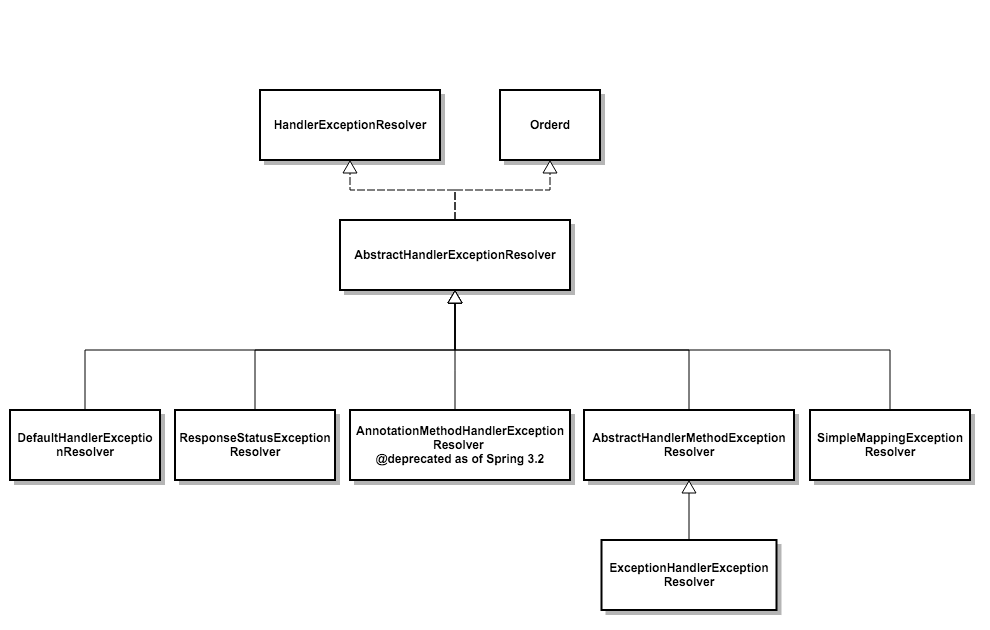Spring MVC异常处理详解
Spring MVC中异常处理的类体系结构
下图中,我画出了Spring MVC中,跟异常处理相关的主要类和接口。

在Spring MVC中,所有用于处理在请求映射和请求处理过程中抛出的异常的类,都要实现HandlerExceptionResolver接口。AbstractHandlerExceptionResolver实现该接口和Orderd接口,是HandlerExceptionResolver类的实现的基类。ResponseStatusExceptionResolver等具体的异常处理类均在AbstractHandlerExceptionResolver之上,实现了具体的异常处理方式。一个基于Spring MVC的Web应用程序中,可以存在多个实现了HandlerExceptionResolver的异常处理类,他们的执行顺序,由其order属性决定, order值越小,越是优先执行, 在执行到第一个返回不是null的ModelAndView的Resolver时,不再执行后续的尚未执行的Resolver的异常处理方法。。
下面我逐个介绍一下SpringMVC提供的这些异常处理类的功能。
DefaultHandlerExceptionResolver
HandlerExceptionResolver接口的默认实现,基本上是Spring MVC内部使用,用来处理Spring定义的各种标准异常,将其转化为相对应的HTTP Status Code。其处理的异常类型有:
handleNoSuchRequestHandlingMethod
handleHttpRequestMethodNotSupported
handleHttpMediaTypeNotSupported
handleMissingServletRequestParameter
handleServletRequestBindingException
handleTypeMismatch
handleHttpMessageNotReadable
handleHttpMessageNotWritable
handleMethodArgumentNotValidException
handleMissingServletRequestParameter
handleMissingServletRequestPartException
handleBindException
ResponseStatusExceptionResolver
用来支持ResponseStatus的使用,处理使用了ResponseStatus注解的异常,根据注解的内容,返回相应的HTTP Status Code和内容给客户端。如果Web应用程序中配置了ResponseStatusExceptionResolver,那么我们就可以使用ResponseStatus注解来注解我们自己编写的异常类,并在Controller中抛出该异常类,之后ResponseStatusExceptionResolver就会自动帮我们处理剩下的工作。
这是一个自己编写的异常,用来表示订单不存在:
@ResponseStatus(value=HttpStatus.NOT_FOUND, reason="No such Order") // 404 public class OrderNotFoundException extends RuntimeException { // ... }
这是一个使用该异常的Controller方法:
@RequestMapping(value="/orders/{id}", method=GET)
public String showOrder(@PathVariable("id") long id, Model model) {
Order order = orderRepository.findOrderById(id);
if (order == null) throw new OrderNotFoundException(id);
model.addAttribute(order);
return "orderDetail";
}
这样,当OrderNotFoundException被抛出时,ResponseStatusExceptionResolver会返回给客户端一个HTTP Status Code为404的响应。
AnnotationMethodHandlerExceptionResolver和ExceptionHandlerExceptionResolver
用来支持ExceptionHandler注解,使用被ExceptionHandler注解所标记的方法来处理异常。其中AnnotationMethodHandlerExceptionResolver在3.0版本中开始提供,ExceptionHandlerExceptionResolver在3.1版本中开始提供,从3.2版本开始,Spring推荐使用ExceptionHandlerExceptionResolver。
如果配置了AnnotationMethodHandlerExceptionResolver和ExceptionHandlerExceptionResolver这两个异常处理bean之一,那么我们就可以使用ExceptionHandler注解来处理异常。
下面是几个ExceptionHandler注解的使用例子:
@Controller public class ExceptionHandlingController { // @RequestHandler methods ... // 以下是异常处理方法 // 将DataIntegrityViolationException转化为Http Status Code为409的响应 @ResponseStatus(value=HttpStatus.CONFLICT, reason="Data integrity violation") // 409 @ExceptionHandler(DataIntegrityViolationException.class) public void conflict() { // Nothing to do } // 针对SQLException和DataAccessException返回视图databaseError @ExceptionHandler({SQLException.class,DataAccessException.class}) public String databaseError() { // Nothing to do. Returns the logical view name of an error page, passed to // the view-resolver(s) in usual way. // Note that the exception is _not_ available to this view (it is not added to // the model) but see "Extending ExceptionHandlerExceptionResolver" below. return "databaseError"; } // 创建ModleAndView,将异常和请求的信息放入到Model中,指定视图名字,并返回该ModleAndView @ExceptionHandler(Exception.class) public ModelAndView handleError(HttpServletRequest req, Exception exception) { logger.error("Request: " + req.getRequestURL() + " raised " + exception); ModelAndView mav = new ModelAndView(); mav.addObject("exception", exception); mav.addObject("url", req.getRequestURL()); mav.setViewName("error"); return mav; } }
需要注意的是,上面例子中的ExceptionHandler方法的作用域,只是在本Controller类中。如果需要使用ExceptionHandler来处理全局的Exception,则需要使用ControllerAdvice注解。
@ControllerAdvice class GlobalDefaultExceptionHandler { public static final String DEFAULT_ERROR_VIEW = "error"; @ExceptionHandler(value = Exception.class) public ModelAndView defaultErrorHandler(HttpServletRequest req, Exception e) throws Exception { // 如果异常使用了ResponseStatus注解,那么重新抛出该异常,Spring框架会处理该异常。 if (AnnotationUtils.findAnnotation(e.getClass(), ResponseStatus.class) != null) throw e; // 否则创建ModleAndView,处理该异常。 ModelAndView mav = new ModelAndView(); mav.addObject("exception", e); mav.addObject("url", req.getRequestURL()); mav.setViewName(DEFAULT_ERROR_VIEW); return mav; } }
SimpleMappingExceptionResolver
提供了将异常映射为视图的能力,高度可定制化。其提供的能力有:
- 根据异常的类型,将异常映射到视图;
- 可以为不符合处理条件没有被处理的异常,指定一个默认的错误返回;
- 处理异常时,记录log信息;
- 指定需要添加到Modle中的Exception属性,从而在视图中展示该属性。
@Configuration @EnableWebMvc public class MvcConfiguration extends WebMvcConfigurerAdapter { @Bean(name="simpleMappingExceptionResolver") public SimpleMappingExceptionResolver createSimpleMappingExceptionResolver() { SimpleMappingExceptionResolver r = new SimpleMappingExceptionResolver(); Properties mappings = new Properties(); mappings.setProperty("DatabaseException", "databaseError"); mappings.setProperty("InvalidCreditCardException", "creditCardError"); r.setExceptionMappings(mappings); // 默认为空 r.setDefaultErrorView("error"); // 默认没有 r.setExceptionAttribute("ex"); r.setWarnLogCategory("example.MvcLogger"); return r; } ... }
自定义ExceptionResolver
Spring MVC的异常处理非常的灵活,如果提供的ExceptionResolver类不能满足使用,我们可以实现自己的异常处理类。可以通过继承SimpleMappingExceptionResolver来定制Mapping的方式和能力,也可以直接继承AbstractHandlerExceptionResolver来实现其它类型的异常处理类。
Spring MVC是如何创建和使用这些Resolver的?
首先看Spring MVC是怎么加载异常处理bean的。
- Spring MVC有两种加载异常处理类的方式,一种是根据类型,这种情况下,会加载ApplicationContext下所有实现了ExceptionResolver接口的bean,并根据其order属性排序,依次调用;一种是根据名字,这种情况下会加载ApplicationContext下,名字为handlerExceptionResolver的bean。
- 不管使用那种加载方式,如果在ApplicationContext中没有找到异常处理bean,那么Spring MVC会加载默认的异常处理bean。
- 默认的异常处理bean定义在DispatcherServlet.properties中。
org.springframework.web.servlet.HandlerExceptionResolver=org.springframework.web.servlet.mvc.annotation.AnnotationMethodHandlerExceptionResolver,\
org.springframework.web.servlet.mvc.annotation.ResponseStatusExceptionResolver,\
org.springframework.web.servlet.mvc.support.DefaultHandlerExceptionResolver
然后看Spring MVC是怎么使用异常处理bean的。
- Spring MVC把请求映射和处理过程放到try catch中,捕获到异常后,使用异常处理bean进行处理。
- 所有异常处理bean按照order属性排序,在处理过程中,遇到第一个成功处理异常的异常处理bean之后,不再调用后续的异常处理bean。
何时该使用何种ExceptionResolver?
Spring提供了很多选择和非常灵活的使用方式,下面是一些使用建议:
- 如果自定义异常类,考虑加上ResponseStatus注解;
- 对于没有ResponseStatus注解的异常,可以通过使用ExceptionHandler+ControllerAdvice注解,或者通过配置SimpleMappingExceptionResolver,来为整个Web应用提供统一的异常处理。
- 如果应用中有些异常处理方式,只针对特定的Controller使用,那么在这个Controller中使用ExceptionHandler注解。
- 不要使用过多的异常处理方式,不然的话,维护起来会很苦恼,因为异常的处理分散在很多不同的地方。
转载:http://www.cnblogs.com/xinzhao/p/4902295.html




【推荐】国内首个AI IDE,深度理解中文开发场景,立即下载体验Trae
【推荐】编程新体验,更懂你的AI,立即体验豆包MarsCode编程助手
【推荐】抖音旗下AI助手豆包,你的智能百科全书,全免费不限次数
【推荐】轻量又高性能的 SSH 工具 IShell:AI 加持,快人一步
· 开发者必知的日志记录最佳实践
· SQL Server 2025 AI相关能力初探
· Linux系列:如何用 C#调用 C方法造成内存泄露
· AI与.NET技术实操系列(二):开始使用ML.NET
· 记一次.NET内存居高不下排查解决与启示
· 阿里最新开源QwQ-32B,效果媲美deepseek-r1满血版,部署成本又又又降低了!
· 开源Multi-agent AI智能体框架aevatar.ai,欢迎大家贡献代码
· Manus重磅发布:全球首款通用AI代理技术深度解析与实战指南
· 被坑几百块钱后,我竟然真的恢复了删除的微信聊天记录!
· 没有Manus邀请码?试试免邀请码的MGX或者开源的OpenManus吧